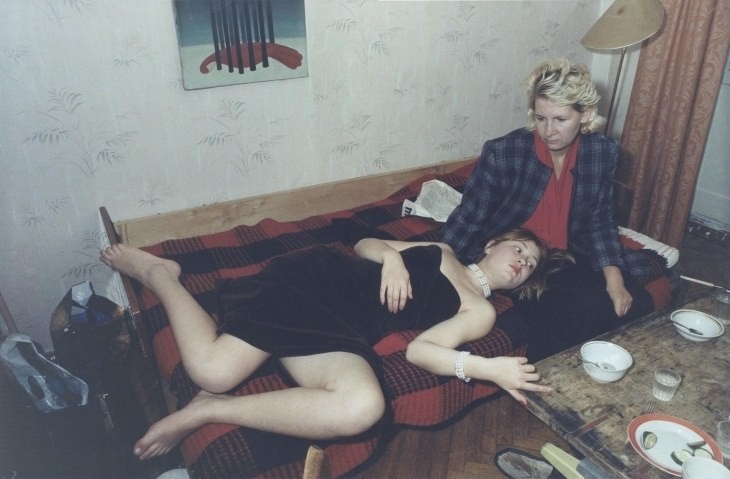Abstract
There are many mysteries in Soviet
history and fate of people and the
Soviet state. Demands of government
left to little of free excess forces. Entire
external activity of the Soviet man went
for the State service. And it left a bleak
stamp on the life of the Soviet man.
People almost do not know how to enjoy
what ever. Government ownership of
immense spaces, accompanied by terrible
centralisation, subordination of whole life
to the State interest and suppression of
free personal and the social forces. There
is no narrowness of the European man in
a Soviet man, European who concentrate
his energy in a small space, Soviet man
up until now does not have this prudence,
ability conserve space and time, culture
intensity.
What happened when USSR collapsed,
what life was like and what is the cultural
aspect. Within my topic I do research
and observe mainstreem style that
comes from past. Eplaning what is
the link between 90’s of east europe
and nowadays of west europe. I am
explaining how aesthetics on post soviet
space remains the same and what is the
reason of that. Since I was a child of big
Perestoyka times when USSR collapsed
and my parents were the one who leaved
two lives (before and after the big wall) I
have a big background and information
source do discover and compare.
It was the 90’s that put an end to censorship and
created the impression of total freedom. The early 90’s,
one of the most controversial times in the recent history
of the former Soviet republics, was an era of cultural
upsurge. The new Post Soviet aesthetic is the epitome
of postmodern irony with its crazy, incoherent, starling
mixture of allusions and motifs. The new collides with
the old in quirky ways.
The Soviet idea of youth was completely sterile, limited
to portraits of wide-eyed adolescent heroes from
socialist murals. In my thesis, I am exploring the scene
of post-soviet individual and comparing it to nowadays
fascination from a western side. What influenced on
what. How style was involved in the design and what it
brought to nowadays. How big is the gap between East
and west and what is the resuld of it.
Summing up, with its candor and irony, wit and
simplicity of design, the new Soviet aesthetic has
garnered hype for a good reason. It’s exciting to watch
this style evolve as designers discover new inspirations
within the Soviet cultural legacy.
Index
Hard period in recent history, which
began in the late 80’s, formally taking
the countdown to the collapse of the
USSR date (26.12.1991) and formally
ended in Russia, renunciation of the
throne of the king Boriska (31.12 in
1999). Briefly atmosphere period can be
characterized as “suddenly everything
was possible (but not all).”
Due to a history of Soviet occupation,
has around 25% ethnic Russian
population. Slavic males (especially
youth) drink vodka and spit out sunflower
seeds while squatting nonchalantly
near the entrance of a corner store. At
least in Russia it comes from the prison
subculture that had also seeped into the
low class general population and became
the so called “gopnik” subculture.
Major Motoko Kusanagi is the main
protagonist in Masamune Shirow’s Ghost in
the Shell anime and manga series. She is a
“full-body prosthesis” .
Umberto Eco ( 5 January 1932
– 19 February 2016) was an Italian
novelist, literary critic, philosopher,
semiotician, and university professor.
Perestroika was a political movement
for reformation within the Communist
Party of the Soviet Union during
the 1980s, widely associated with
Soviet leader Mikhail Gorbachevand
his glasnost (meaning “openness”)
policy reform. The literal meaning of
perestroika is “restructuring”, referring
to the restructuring of the Soviet political
and economic system. Perestroika is
sometimes argued to be a cause of
the dissolution of the Soviet Union, the
revolutions of 1989 in Eastern Europe,
and the end of the Cold War.
References
LITERATURE
Magazine/newspaper article:
1. Syrkov, V. “Freedom to free speech on Art topic”, Reklama, 1991. p.28-29
2. Pelovskiy, R. “Design and us”, Reklama, 1990. p.10-13
Exhibition:
1. Plakat style from USSR to 21 Century, Kiev, Ukraine, Arsenale, 11.10.2016
Web sources:
1. Sbitnev, N. (2007) Commercial style in a graphic design. Available at: http://www.bo0k.net/index.
php?p=achapter&bid=13350&chapter=1
(Accessed: 3 January 2017).
2. Fedorova, A. (2016) How to be a man: A new generation of artists is rethinking the meaning of masculinity
in Russia. Available at: http://calvertjournal.com/features/show/5472/post-soviet-youth-masculinity-
boyhood-Russia (Accessed: 5 January 2017).
3. Leach, A. (2016) Why 2016 was the year of post-soviet fashion. Available at: http://www.highsnobiety.
com/2016/12/28/post-soviet-fashion-vetements-gosha/ (Accessed: 2 January 2017).
4. 90’s (2000) Available at: https://lurkmore.to/Девяностые (Accessed: 2 January 2017).
Books:
1. Igrickii YI, Shanshieva LN, 1990-2010, Generation of Change in Eastern Europe. Moscow
2. Pavlinskaya A., 1962 ,Graphics around us. Moscow., p. 47


